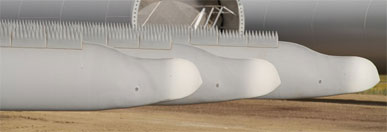General Electric and Siemens, both big players in wind, are pushing the envelope to develop new turbine designs that can put wind energy on equal economic footing with traditional fossil fuels.
GE, Virginia Polytechnic Institute, Virginia Tech, and the National Renewable Energy Lab (NREL) are working on a project that could fundamentally change the way wind blades are designed, manufactured and installed.
The 3-year project is funded by a $5.6 million ARPA-E award.
The focus of the research is a new architectural fabric that’s lighter than the fiberglass typically used in turbines.
Because it is lightweight and flexible, the fabric allows engineers to redesign the shape and length of blades so they can capture more wind at lower speeds. It’s also easier to install and to operate reliably over time, says GE. And it could cut the costs of producing turbine blades 25%-40%.
These advances could spur development of larger, lighter turbines compared to today’s which past a certain size are hard to maneuver and transport. Components could be built and assembled on site.
It’s estimated that to achieve the national goal of 20% wind power in the US, wind blades would have to be 50% longer, and that’s virtually impossible with current technology restraints.
"Developing larger wind blades is the key to expanding wind energy into areas we wouldn’t think of today as suitable for harvesting wind power. Tapping into moderate wind speed markets, in places like the Midwest, will only help grow the industry in the years to come," says Wendy Lin, a GE Principal Engineer.
New Siemens Blade Design Borrows from Dinosaurs
Siemens is likewise working on bigger, lighter technology that can produce more energy.
It recently debuted a massive 6-megawatt (MW) turbine for offshore wind that’s the lightest in its class.
If wind farm output can be increased just 1.5% – like at the 125 MW Altamont Pass Wind Farm in California, that would supply energy to an additional 2500 households.
Rather than replace existing machines, which is expensive, Siemens has come up with a way to upgrade those machines to produce more energy.
Using attachments that take their inspiration from the shape of a dinosaur’s body, "DinoTails" increases the surface area of the blade, helping it produce more power, while reduces turbulence and noise.

A second attachment, "DinoShells," has a shovel-nose design that makes it more efficient by extending the shape of the blade farther down to where it connects with the shaft. And a third design features small fins that force the air to stay in contact with the top of the blade for longer, increasing lift.
The components are being added to the Bison 2 and 3 Wind Energy Centers in North Dakota by the end of the year, where they are expected to provide a 3.15 MW boost in generation capacity.
